
|
Hirsute Reflections: Part 1 Some Thoughts About Hairs, Fibers and Bristles by Richard L. Howey, Wyoming, USA |
“But my brother Esau was an hairy man but I am a smooth man” (first verse of the fourteenth chapter of the Second Book of Kings) as Beyond The Fringe in a biblical parody reminds us in one of their rambles and we all know about what happened to Samson when his hair was shorn. As a whole, mammals are a hairy lot with exceptions which by now we always expect Mother Nature to come up with; such as, the naked mole rat and the perverse cross breedings that humans have perpetrated to get pathetic hairless cats and dogs. If you want a pet and are allergic to cat and/or dog hair, then buy a Komodo Dragon Lizard!
Among humans, there are all kinds of eccentric fads and fashions with regard to hair. Some people love long, flowing tresses which are high maintenance and help keep the shampoo people in business. Others seem to hate hair and shave their heads, perhaps to look more like naked mole rats, who knows? Then, there are the spiky Mohawk hair styles, the more artfully done of which, remind me of the raised crests of cockatoos. In my school days, there was always a teacher or two or three who had a spinster’s bun at the back of her head and, of course, girls with braids and elaborate twists. I remember in 5th grade, we had old wooden desks with built-in inkwells. There was a girl who sat in from of me, who had very long braids and, on one occasion, obnoxious child that I was, I couldn’t resist dipping the tip of her right braid in my inkwell. After a few minutes, the girl discovered this desecration and let out a howl bringing the teacher–a woman with a spinster’s bun, rushing over to investigate. When she discovered what had happened, she gave me a sharp slap across the cheek. I suppose this taught me a bit of self-control, but I must admit that even after all these years, I still relish the ink-dipping episode; the obnoxious child in each of us never completely disappears.
The degree of hairiness varies considerably between human beings; some seem almost completely smooth, whereas there are those who seem to rather resemble a primate version of the Wooly Mammoth. Hair happens to be one of those items that humans in virtually every culture have concerned themselves with in an intensely serious way. The elaborate coiffures of elite ancient Egyptian women were packed with dried camel dung to hold their shape, thus the heavy demand for incense, fragrant oils, and strong perfumes. I quite suspect that in that culture only slaves functioned as beauticians and then probably not by choice. Or consider the complex braiding of the Rastafarians or the elaborate hair sculpting of some North African tribes. You can find some striking examples in Leni Riefenstahl’s book of photographs titled: The People of Kau. In Western societies, bits of hair were put into lockets or compartments in bracelets or rings either as love tokens or symbols of mourning. Human hair was woven into pieces of very elaborate “jewelry” and the patience required to produce these artifacts staggers the imagination. American Indians used porcupine quills (which are modified hairs) to weave intricate decoration and sometimes even small baskets.
So, hair is something common and yet extraordinary and when we start examining it with the microscope, it becomes even more remarkable. Let us begin with an image of a bit trimmed from my ancient and thinning locks.

Pretty unimpressive, what? Well, as it turns out, hairs (or least many types) are birefringent, so let’s look at the same sample with polarized light.

Now, you should be at least slightly impressed. I fantasize about walking around with a full, rich head of hair that would look like that in natural light–I could become the mature, distinguished, erotic objet du jour.
When hair turns gray, this is attributed to a loss of pigment cells. My beard is quite gray, so let’s take a peek at a bit of it; first with brightfield and then with polarization. The fourth image was taken with the addition of a Red 1 compensator.



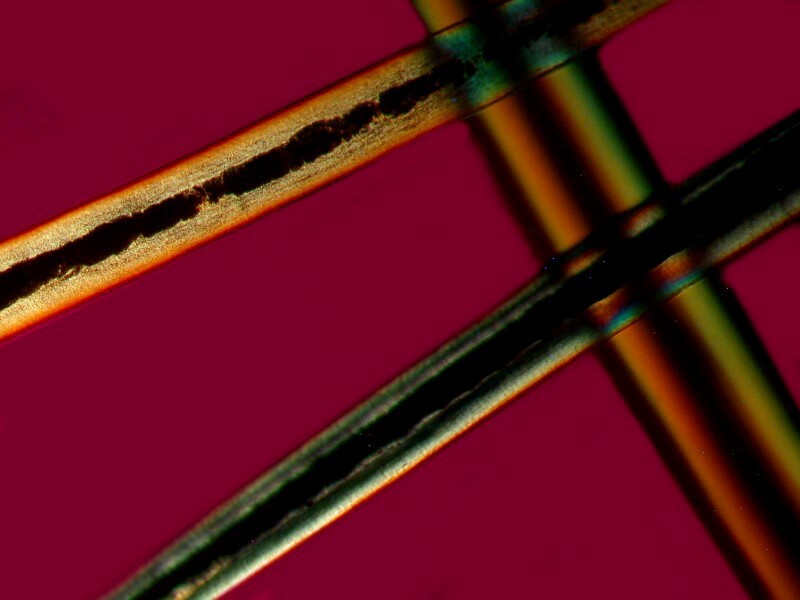
We have rather recently discovered that even the lowly hair can contain cells that will give a map of our unique DNA. Just think, everywhere we go, we walk around leaving biological calling cards of ourselves. So, if you’re considering committing a serious crime, wear a full biohazard suit and then burn it afterwards. If there are any witnesses, they’ll probably say that it was done by some alien.
Thick hair on mammals can be both a blessing and a curse. in winter, a thick coat can mean survival, but during a hot summer, it can mean misery, heat prostration, and even death. So, many mammals learned the trick of seasonal shedding; we have a male Norwegian Forest Cat with a thick second undercoat and he sheds heavily–we don’t let him outside–and he hasn’t yet learned to brush and comb himself, so every morning, I gently extract a handful or two of hair–I don’t know how he manages to continue to produce it in such quantity, but he is a virtual hair factory. So, it would be remiss of me not to show you 3 images of his biological bounty. The second is a close-up and the third shows you that not all hair is spectacularly birefringent; in this case, the birefringence is quite weak.


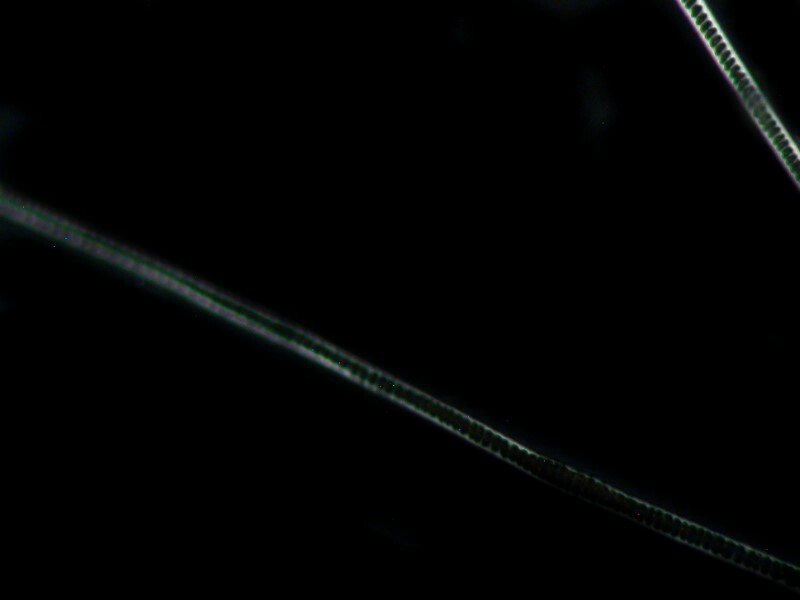
The down side of this hirsute armor is that for many animals, it becomes a refuge for all kinds of nasty, invasive, and irritating little critters–fleas, ticks, lice, mites, spiders, flies, and even bizarre little worm-like creatures which are actually mites and live in the follicles of eyelashes.
Look at the head of a fly or rather the mouth parts of a blowfly.
And what do we find here?–hairs and bristles!

or the surface of a spider.
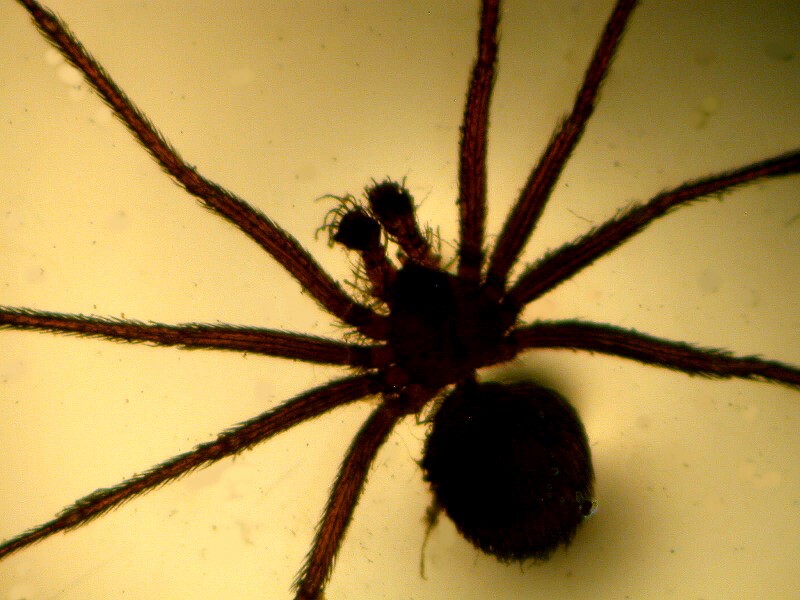
Even the little bright red free-swimming water mites are covered with hairs.
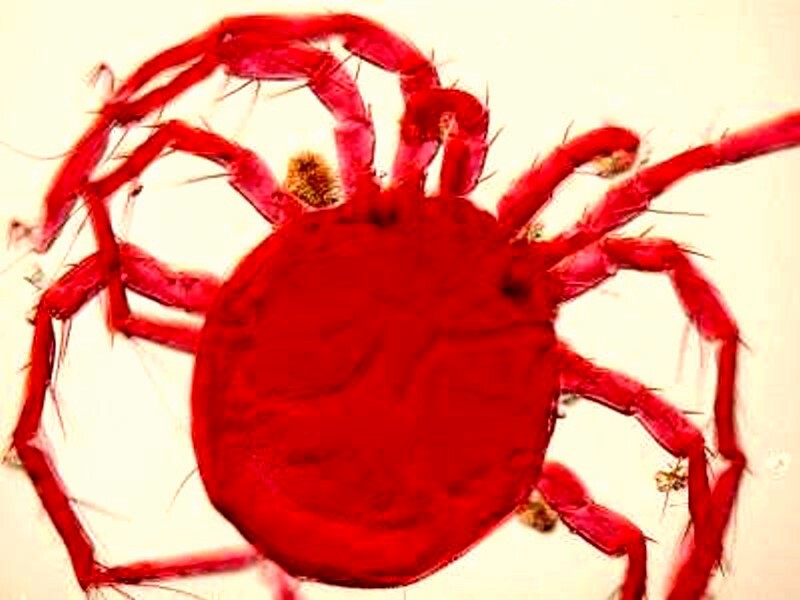
And beetles which we tend to think of in relation to their hard “shells” (elytra, which are really wing cases) have substantial quantities of hairs. This is a splendidly colorful beetle of the genus Belinota.

And just look at this splendid weevil. The second image shows you a close-up of a claw at the tip of a foot.
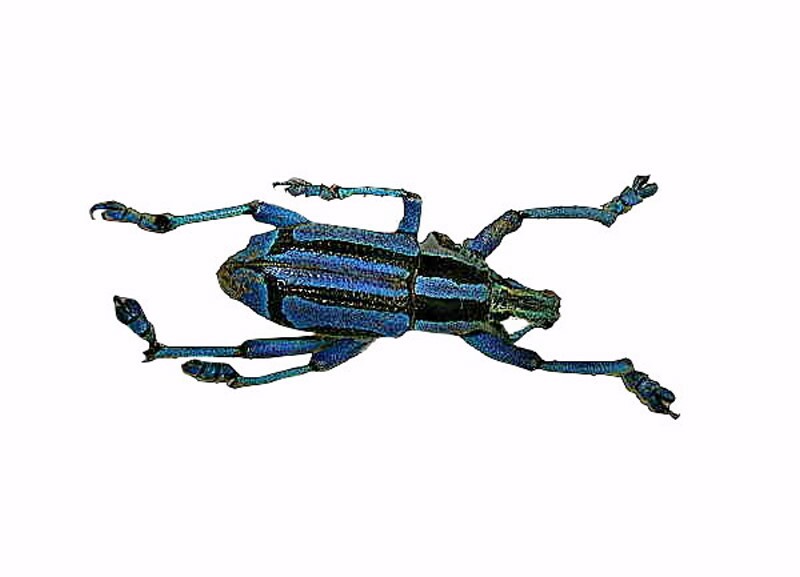
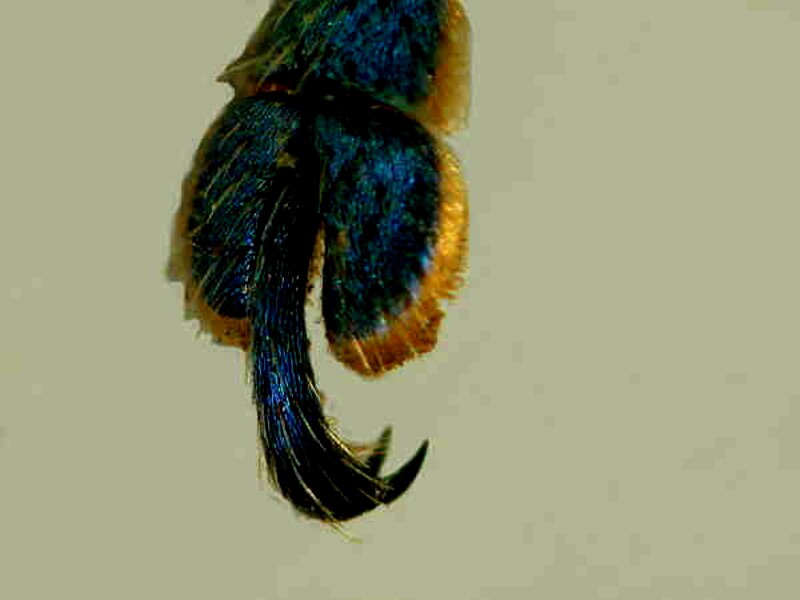
If you’re patient and persistent enough, you will discover that even these “lowly” creatures provide housing for yet smaller beasties.
However, let’s go back to the mammals for a bit. We have had a glimpse of the extraordinary Howey hair and the exceptional hair of his cat, so it’s time to branch out to something a bit more exotic like bat hair, mouse hair, moose hair, and maybe even some Wooly Mammoth hair, if I can find the slide. We tend to think of hairs as being essentially smooth and fundamentally undifferentiated. Generally hairs are composed of 3 layers: 1) cuticle–the outer layer which may be relatively smooth or finely sculpted. 2)The inner layer or medulla which can be continuous, fragmented, or discontinuous. 3) The cortex which is the intermediate layer between the cuticle and the medulla which is usually the least differentiated area.
The cuticle of bat hair is often structured in an interesting manner, so the next time a vampire bat gets tangled in your hair, after your shrieks and screams have frightened the poor thing to death, carefully brush your hair and put the leavings in a plastic dish. Under the microscope, you should be able to easily distinguish the bat hair from your own. Bat hair is interesting because it has minute, thorny projections from the cuticle and just in terms of general form rather reminds me of the hydrozoan Sertularia.
I was going to take some images of bat hair and show them to you, but I can’t find my jar of bats. Years ago, I bought 24 small, preserved specimens from Turtox. I hoped to examine them for both internal and external parasites. Now, I have misplaced the jar; I thought they were in my small upstairs lab–but, no. And they’re not in my larger upstairs lab area nor are they in the basement. (I even searched my own belfry–but no bats.) My wife is convinced that I am in the process of converting the entire house into lab areas which I have told her repeatedly is utter nonsense–the kitchen and the dining room are sacrosanct–proper food is necessary to keep up ones strength to do good microscopy.
If I find the jar of bats, I’ll take some pictures of their hair and include them with this essay.
Mouse hair is fairly easily obtainable either from your garden, a university research lab, or a pet store. However, you’ll find that it’s not very impressive, but if you look at some, it will help you understand what people mean when they describe someone’s hair as “mousey”.
If you get really interested in different types of hairs, there is a fairly wide variety that is rather easily available and here I am referring to roadkill. (I can’t resist mentioning that here at the university, some of my colleagues and I refer to the Faculty/Staff Dining Room as The Roadkill Café.) Exploiting this resource, you can collect hare hair (Sorry, couldn’t resist. I know that in some countries I would be taken out and flogged for subjecting decent citizens to such pun-ishment.), squirrel hair, hair from a variety of small rodents, etc. A word of CAUTION: ALWAYS follow good procedure to collect samples. 1) Be careful not to come in contact with the blood or tissue of the animals. 2) Take the hair samples with scissors, forceps and place them in small plastic bags and label them. 3) Under no circumstances should you try to collect the remains of the entire animal. With animals like moose, elephants, and Stegosauruses, the reasons for this are obvious. However, ground squirrels and other animals of small size might be tempting but, let me remind you that some of these cute little creatures or their ectoparasites or symbionts are vectors for plagues, Hanta virus fever, etc. So–wear gloves and minimize contact with the animal unless you are wearing a biohazard suit. 4) Don’t try to move the remains of a dead animal off of a highway; remember there are demented medical students out there prowling the highways for hair collectors in order to run over them and harvest their organs for transplants.
We Interrupt This Program For A Special Announcement
I found the jar of bats! I was completely convinced that they were in my small lab upstairs and that I had not moved them. This afternoon, I made another foray into the basement and went through all of my specimen drawers. No luck! I went back upstairs into the small lab and went to the large shelf where I had last seen them. No luck. I looked through the jars under the table, the jars in my chemical cabinet which has a few bottles of specimens on the bottom shelf–no luck. I went through the jars on a side table and noticed a black plastic 2 gallon bucket which had a tray sitting on top of it. I removed the tray and there, basking in the black bucket, was a bottle full of bats. As an aside, I will note that this noteworthy event occurred on Christmas afternoon; it did not however produce a conversion experience, but I do regard it as another significant triumph over senility.
Bats are surprisingly hairy creatures and range in size from ones that will fit in the palm of your hand to the largest fruit bats which can have a length of 1.5 feet and a wingspan of up to 5 ½ feet!! These remarkable creatures can glide from tree to tree as a consequence of the membranes which stretch from the fore limbs to the back limbs. The echolocation system of bats is one of the marvels of nature; their aeronautical feats, the amazing articulation of their skeleton, their remarkable ears, and the sometimes bizarre noses are all sources of amazement. Admittedly, however, they do have, from our point of view, a number of off-putting and downright disgusting behaviors and habits. A cave full of bats is a distinctly unpleasant place to find oneself since the floor may be covered with a thick layer of guano and if you wander around in the cave for long, you may end up that way as well. From our perspective, bats are genetically gregarious to a fault but, in defense of bats, I would say that vast numbers of creatures of virtually any species make us deeply uncomfortable. The one exception, for many, is masses of other human beings when hundreds of thousands of them gather together for political or religious causes. I must be missing a basic set of genes, for I would rather risk a cave full of bats than a frenzied herd of humans.
I clipped some hairs and hoped they would show us some interesting structure.
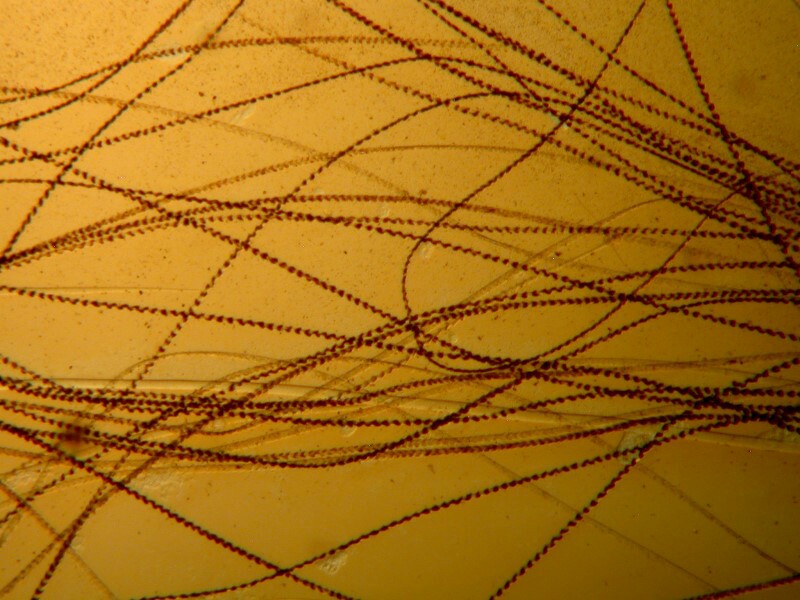
Here is a close-up.
And once again, we encounter a case where there is virtually no birefringence so I won’t even bother you with an image.
Let’s look at just a few more examples from the animal world. First, we’ll look at an example from a Prairie Dog. Note that these hairs are distinctly curled. The first images Is brightfield, the second polarized, and the third polarized with a Red 1 compensator.
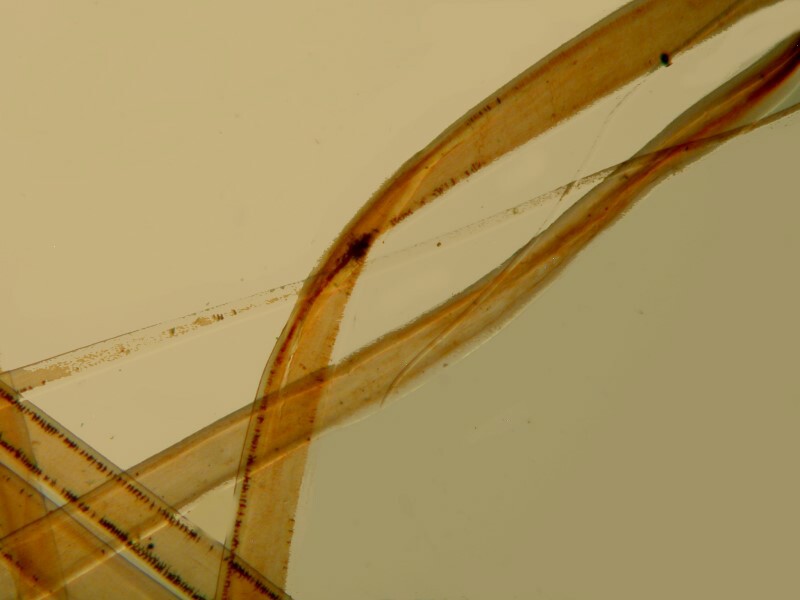
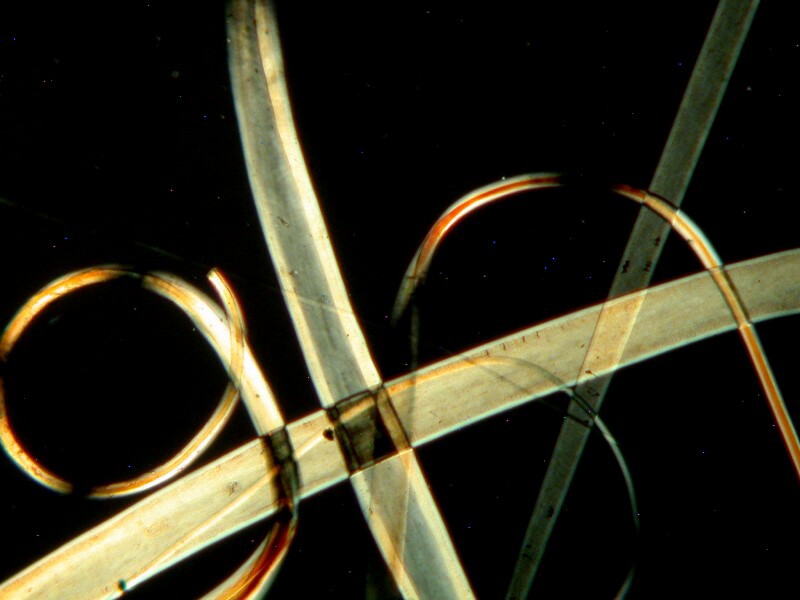
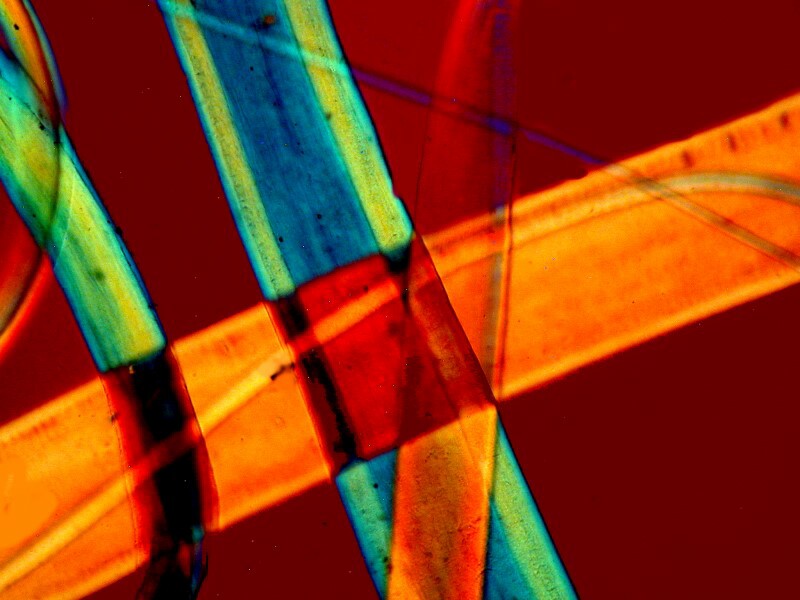
Often larval insect stages have an abundant supply of hairs and they frequently have a sensory function. Here are a few hairs from a caterpillar.
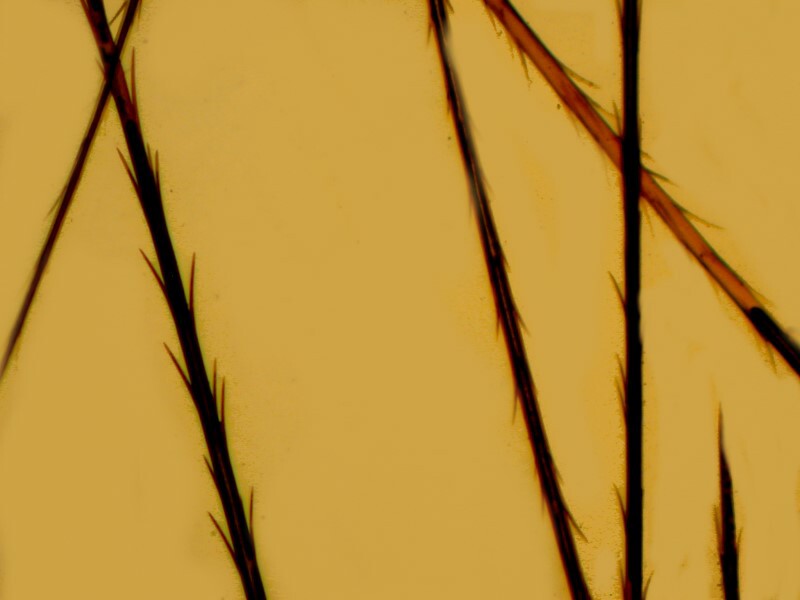
Even marine worms have modified hairs or setae or bristles and we are going to take a look at some from a rather unattractive creature with the ironic name of Aphrodite. It has also been described as a sea mouse. This is large marine worm and this specimen is about 7 inches long and 2 and ½ inches wide. It has many bristles which are hidden by the accumulation of debris on its dorsal surface. The properties of the bristles are optically remarkable and surpass our own accomplishments in terms of fiber optics. These structures are quite striking under polarized light as you will see. However, first a few of the ugly critter, then a cluster of setae under polarized light and then 2 close-ups of individual bristles under polarized light.
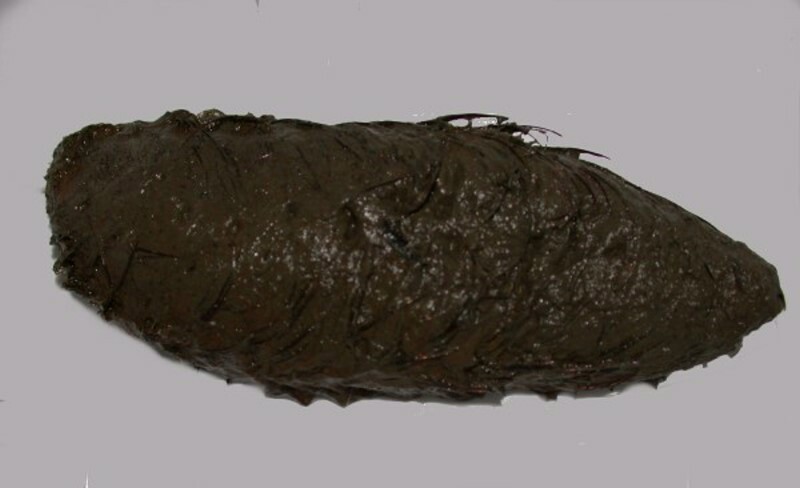
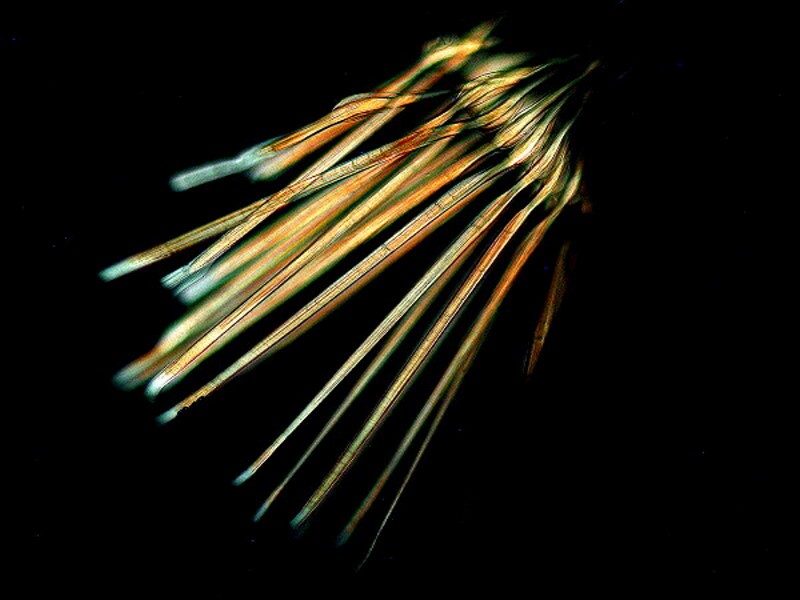
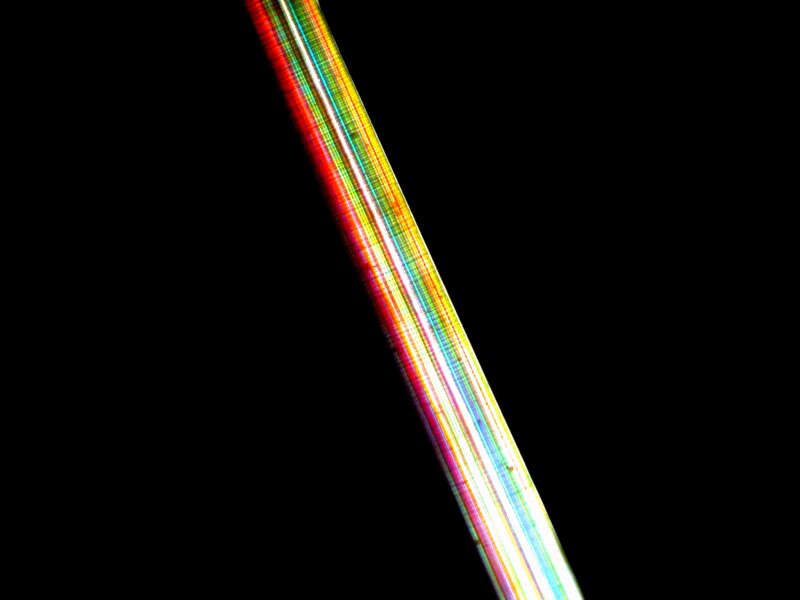
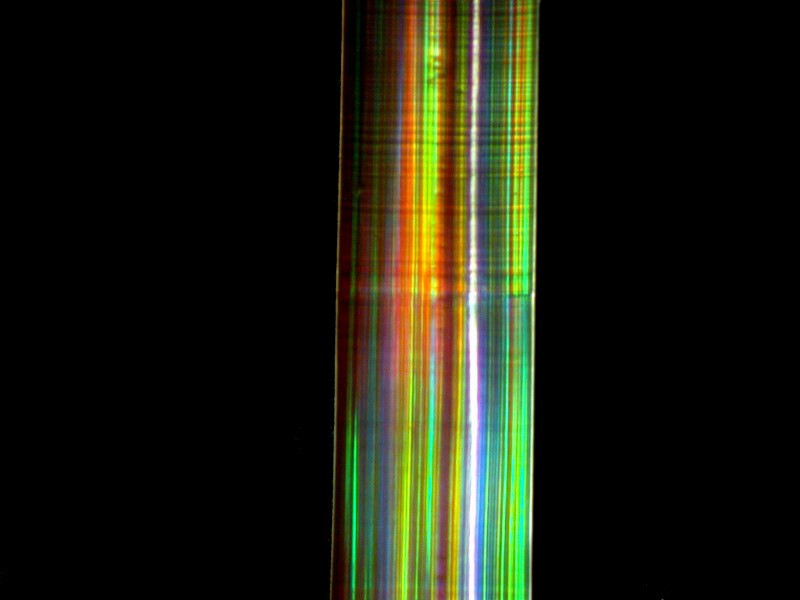
And now a truly exotic treat–tiger hair. I’m sure that any of you who had an English literature course are familiar with William Blake’s famous poem which starts out:
“Tyger! Tyger! burning bright
In the forest of the night,”
However, not everyone found Blake’s ponderously metaphysical mysticism to their taste and the American humorous poet Ogden Nash wrote a 2 line jab titled:
Epitaph For an Explorer
Tiger, Tiger, my mistake.
I thought that you were William Blake.
First, brightfield, the polarization, the polarization with a Red 1 compensator.
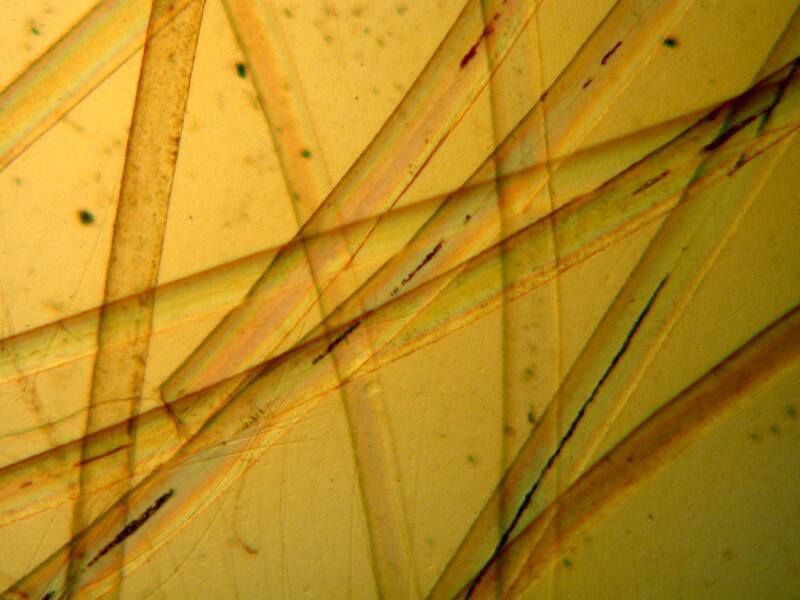
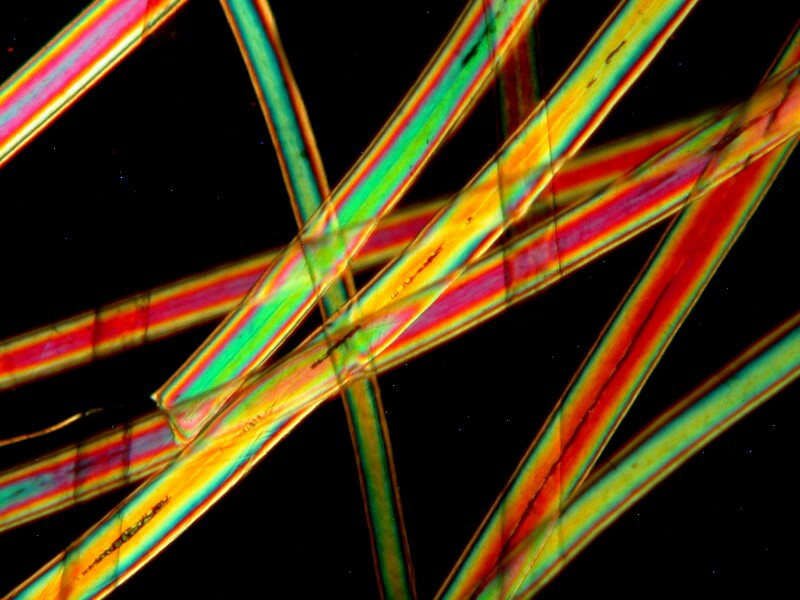
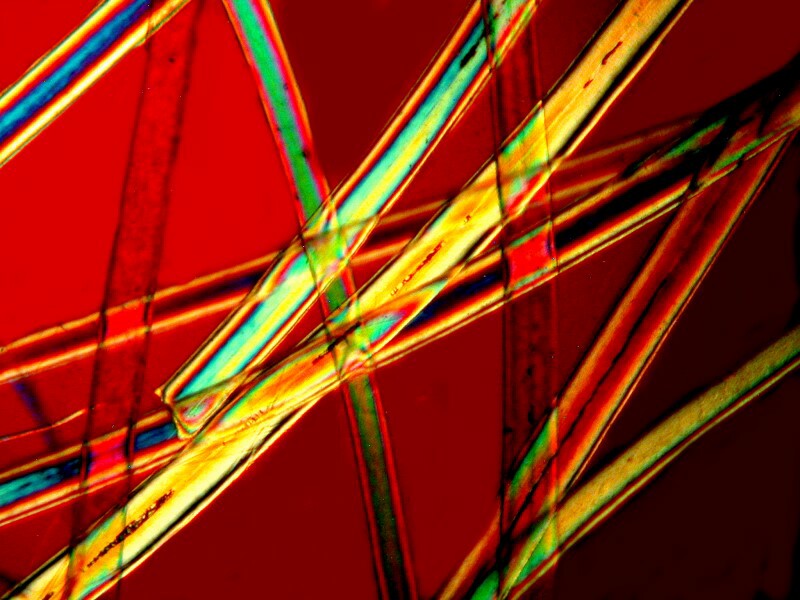
Hairs are by no means restricted to the animal kingdom and when I pluck a leaf from one of my wife’s African violets, I find that it’s downright fuzzy. Now, I suppose we get into a quibble here about definitions. Animals hairs are predominately keratin whereas plant hairs are usually composed of cellulose compounds. And then what about cactus spines and bristles from polychaetes? Here, I’m going to adopt the attitude of Lewis Carroll’s Humpty Dumpty when Alice protests:
"When I use a word," Humpty Dumpty said, in rather a scornful tone, "it means just what I choose it to mean—neither more nor less."
"The question is," said Alice, "whether you can make words mean so many different things."
"The question is," said Humpty Dumpty, "which is to be master—that's all."
It’s my essay, so here spines, bristle, and fibers are all hairs as far as I’m concerned for this discussion and, if like Alice, you wish to take exception then go look at some of Brian Johnston’s gorgeous flower images–always a treat–and stop reading this essay.
So, now that that’s settled, here are images of some hairs from the violet; the first shows the edge of a leaf and the second is of the stem of the leaf.
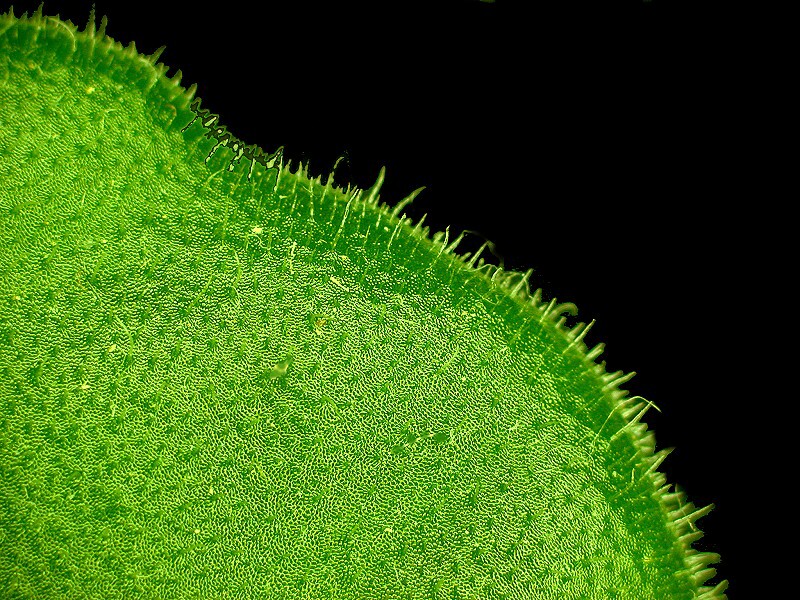
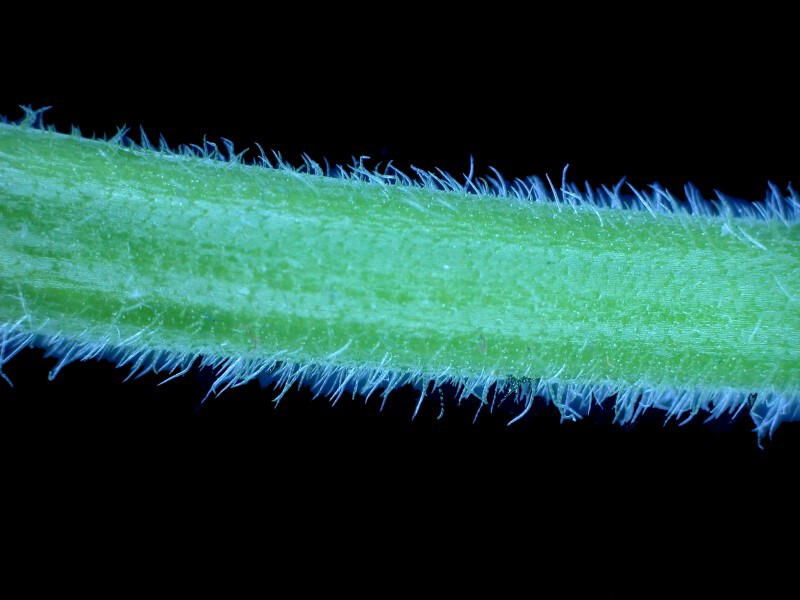
While I was vandalizing a violet, I got curious about a nearby zygocactus and noticed that on the terminal leaf on one branch, there were tiny hairs and so I decided we should look at these too. First, all show you a flower and then the hairs at the tip of the leaf.

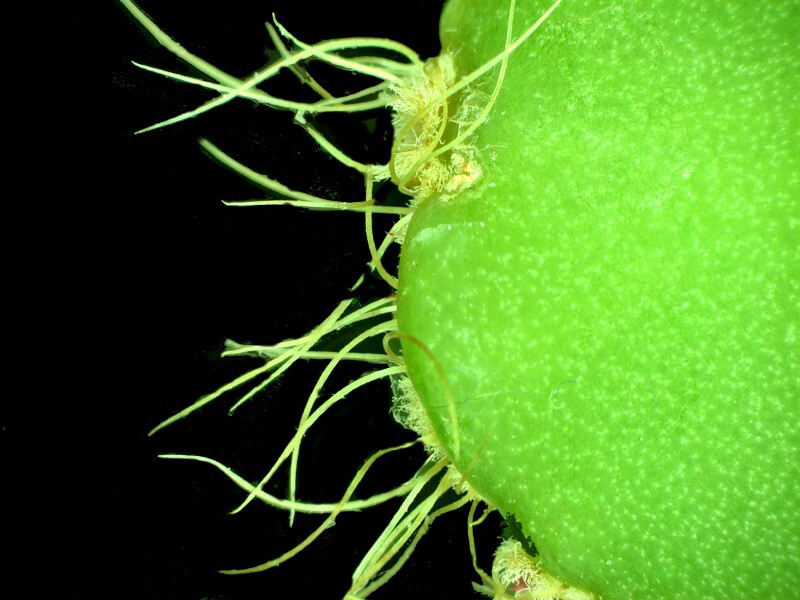
This reminded me that in an upstairs window, I have a small very spiny cactus for which I lost the identifying tag, so I don’t know what kind it is. In any case it’s dead; I discovered that even cacti can dry up.
While the spines are slim, abundant and very sharp, they are, microscopically speaking relatively thick–a project for Micro-Scalpel Man! (Oh No!–Another digression–but an important one.) We invest considerable sums in our microscopes and attachments but are, sometimes, I fear, rather casual about our purchases of micro-tools. The investment in a few quality micro-tools can enhance your microscopy in surprising and very satisfying ways. I recommend having at least 2 pairs of micro fine-pointed tweezers that are up to Swiss standards, a micro-scalpel, preferably with a handle that will accept other micro-tools; at least 2 pairs of micro-scissors, one with straight tips, the other with slightly curved ones; a small assortment of micro-chisels;
20 or so dissecting needles and a small diamond hone. The needles and the hone you can use to make all kinds of handy little micro-tools and resharpen them as needed. None of these items is particularly expensive with the exception of the micro-scalpel with replaceable tips. If you have the proper hand tools, goggles, and skill, you can make your own micro-scalpels by breaking pieces off of a double-edged razor blade and mounting them in appropriate craft knife handles. This must be done with great care as the steel in such razor blades is extremely brittle and extremely sharp, so such an operation must be carried out in such a way as to eliminate any flying fragments. You have a choice. You can buy insurance and spend $10,000 to hire a cost-benefit/risk analyst to have them make an informed recommendation for you regarding the wisdom of undertaking the task of making micro-scalpels for yourself. Amazing how complicated this hyper-post-modern world has become. In short, buy some good micro-tools; they will make your specimen preparation easier and your microscopy more fun and satisfying.
Oh, yes, here is a look at one of the cactus spines.
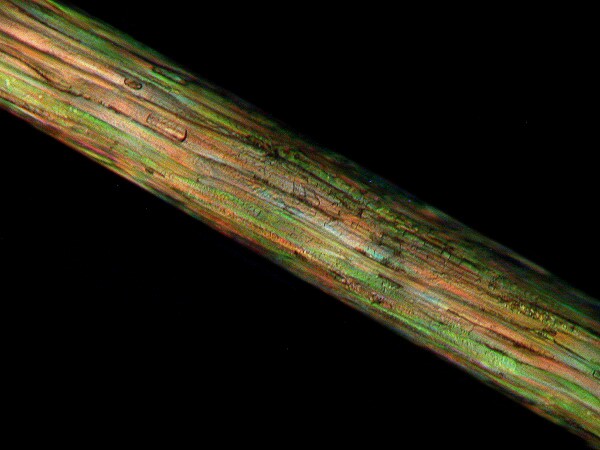
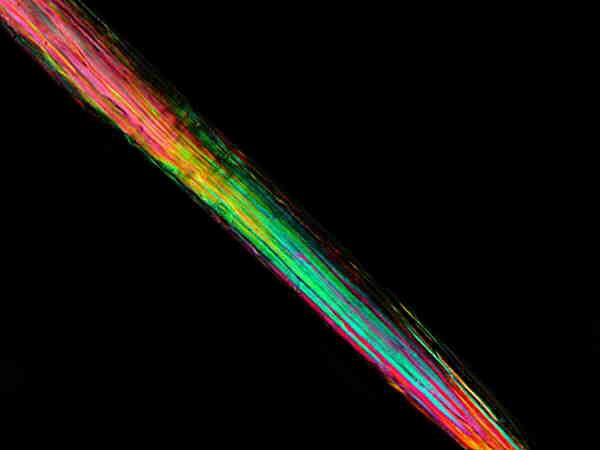
If you wish to explore plant hairs further, there is certainly no shortage of material, but I will make a suggestion, namely, that you might find some very, very intriguing material in the insectivorous plants, like the Venus Flytrap and the Sundew.
While we’re still on plant materials, we should say a few words about fibers. There are plant, synthetic, and moral fibers, although I guess these last are unfortunately not subject to microscopic examination. Virtually every household has cotton in some form or other. However, rather than cutting up one of your wife’s or mother’s dresses, I suggest using a cotton swab. With your forceps, you can pluck off a few fibers and put them in a drop of water on a slide.
Next, get out your shears and go chase down a sheep so that we can get a look at some wool. If, however, you’re lazy like me you’ll just chase down an old moth-eaten wool scarf instead and take a tiny sample for microscopic examination.
Now, we all know that DuPont and other major chemical companies, with a deep commitment to animal and plant rights, spent enormous sums developing synthetic fibers so that sheep and plants could stay warm. There’s Nylon, Dacron, Rayon, Spandex, Kevlar, Polyester, Dynel and over 50 others. So you can extract a couple of examples from bits of clothing at the back of your closet. You probably haven’t worn them in years because they keep getting smaller and, as a consequence, no longer complement your distinguished figure.
In Part 2, I shall show you some hairs from less common animals, such as deer, porcupine, and even a moose.
All comments to the author Richard Howey are welcomed.
Editor's note: Visit Richard Howey's new website at http://rhowey.googlepages.com/home where he plans to share aspects of his wide interests.
Microscopy UK Front
Page
Micscape
Magazine
Article
Library
Published in the September 2013 edition of Micscape Magazine.
Please report any Web problems or offer general comments to the Micscape Editor .
Micscape is the on-line monthly magazine of the Microscopy UK website at Microscopy-UK .
©
Onview.net Ltd, Microscopy-UK, and all contributors 1995
onwards. All rights reserved.
Main site is at
www.microscopy-uk.org.uk .